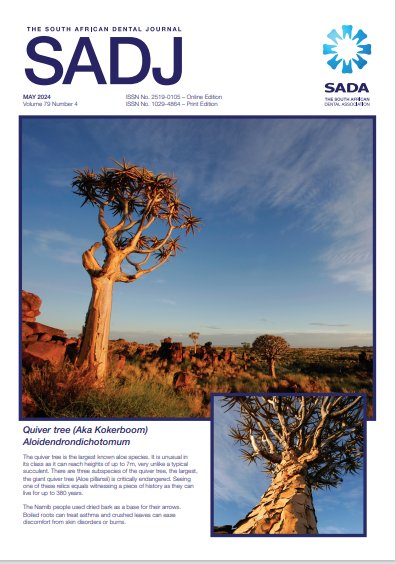Supersession: Collegiality to the rescue
Keywords:
Supercession, McQuoid-Mason, invokeAbstract
An extensive search of the literature shows a huge dearth in scholarly opinion on supersession. The debates surrounding supersession have evoked deep emotions and polarised the cadres of oral health. Allegations of practitioners completing dental treatment on a patient without consulting the original dentists are rife. We speculate that this concept is unknown, poorly explained and understood, hence the difficulty to implement it in different clinical scenarios. A random survey of oral health professionals was undertaken to canvass views, opinions and understandings of the concept and application of supersession. The findings indicate a multiplicity of viewpoints and understandings of supersession. Additionally, Rule No 10 of the HPCSA was considered to be unclear, “murky” and less instructive on how to avoid supersession. For these reasons, practitioners tend to act out of sync with the expected provisions from
the regulator. It is hence the objective of this paper to provide very clear criteria and a roadmap in dealing with alleged supersession.
Downloads
References
Ethical Rules of Conduct for Practitioners Registered under the Health Professions Act, 1974, 4 August 2006 amended 2009 and 2010
Govan P. (2016). Supersession. South African Dental Journal. 2016; 71(8): 370-1
South Africa. Department of Trade and Industry. Competition Act, 2009 (Act No. 89 of 1998). (Notice for an application for exemption. Government Gazette No. 32253
McQuoid-Mason D, Dada M. A-Z of Medical Law, 1st ed. Cape Town: Juta and Company Ltd, 2011
Coode G. On Legislative Expression: or the Language of the Written Law. Law Library. 1848; 60(1):1833-60
Fletcher GP. The Right and the Reasonable. Harvard Law Review. 1985;98(5): 949-82
Corten O. The Notion of “Reasonable” in International Law: Legal Discourse, Reason and Contradictions. International and Comparative Law Quarterly. 1999;48(3):613-625. doi:10.1017/S0020589300063454
Griffey B. The ‘Reasonableness’ Test: Assessing Violations of State Obligations under the Optional Protocol to the International Covenant on Economic, Social and Cultural Rights. Human Rights Law Review. 2011;11(2): 275-327
Avant LC, Swetz KM. (2020). Revisiting beneficence: what is a ‘Benefit’, and by what criteria? The American Journal of Bioethics. 2020;20(3):75-7
Crisp R. The duty to do the best for one’s patient. Journal of Medical Ethics. 2015; 41(3): 220-3
Omonzejele PF. Obligation of non-maleficence: moral dilemma in physician-patient relationship. Journal of Medicine and Biomedical Research. 2005;4(1):22-30
Motloba PD. (2019). Non-maleficence – a disremembered moral obligation. South African Dental Journal. 2019;74(1): 40-42
Kilbride MK, Joffe S. The new age of patient autonomy: implications for the patient-physician relationship. JAMA. 2018;320(19): 1973-4
Bester JC. Beneficence, Interests, and Wellbeing in Medicine: What It Means to Provide Benefit to Patients. Am J Bioeth. 2020;20(3):53-62. doi: 10.1080/15265161.2020.1714793
Srivastav S. Essentials of a Valid Contract. Indian Journal of Law and Legal Research. 2021;3(3):1
Van Dokkum, N. Hospital consent forms. Stellenbosch L. Rev. 1997;7: 249
Eisenberg MA. Why there is no law of relational contracts. Nw. UL Rev. 1999;94:805
Mangiardi JR, Pellegrino ED. Collegiality: what is it? Bull New York Acad Med J Urban Heal. 1992; 68: 292-6
Bess J. Collegiality: toward a clarification of meaning and function. Higher Education: Handbook of Theory and Research. Volume III. Agathon Press. 1992: 1-36
Betzler M, Löschke J. Collegial relationships. Ethical Theory Moral Pract. 2021; 24: 213-229
Loh LC. Collegiality: a fix for our current crisis. Can Fam Physician. 2023;69(2):146. doi: 10.46747/cfp.6902146
Barros PP, Brouwer WBF, Thomson S et al. Competition among health care providers: helpful or harmful? Eur J Heal Econ. 2016; 17: 229-233
Attwood CA, Wellik KE. Cooperation. Clinical Journal of Oncology Nursing. 2012;16(5): 487-
doi.org. 10.1188/12.CJON.487-490
Ng IK, Tan SM, Law LS et al. Spotlighting ‘Medical Collegiality’. JR Coll Physicians Edinb. 2023;30:14782715231221833. doi: 10.1177/14782715231221833
Downloads
Published
Issue
Section
License

This work is licensed under a Creative Commons Attribution-NonCommercial 4.0 International License.





.png)